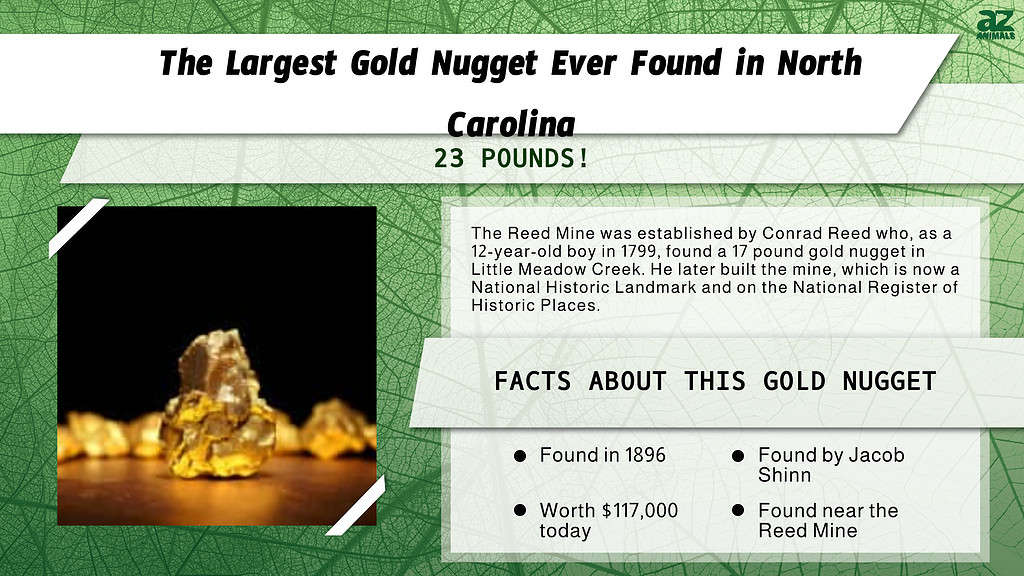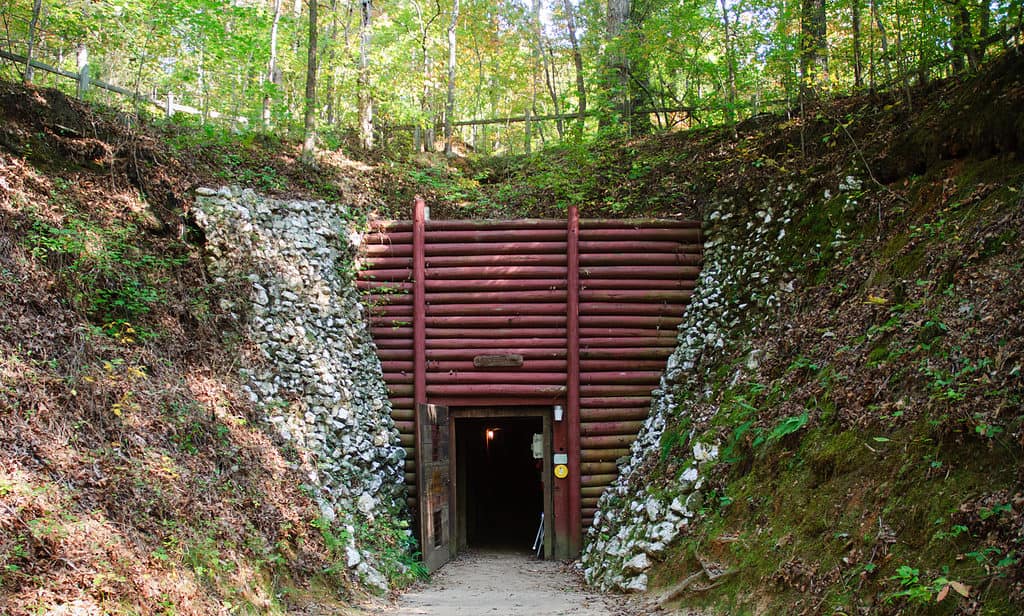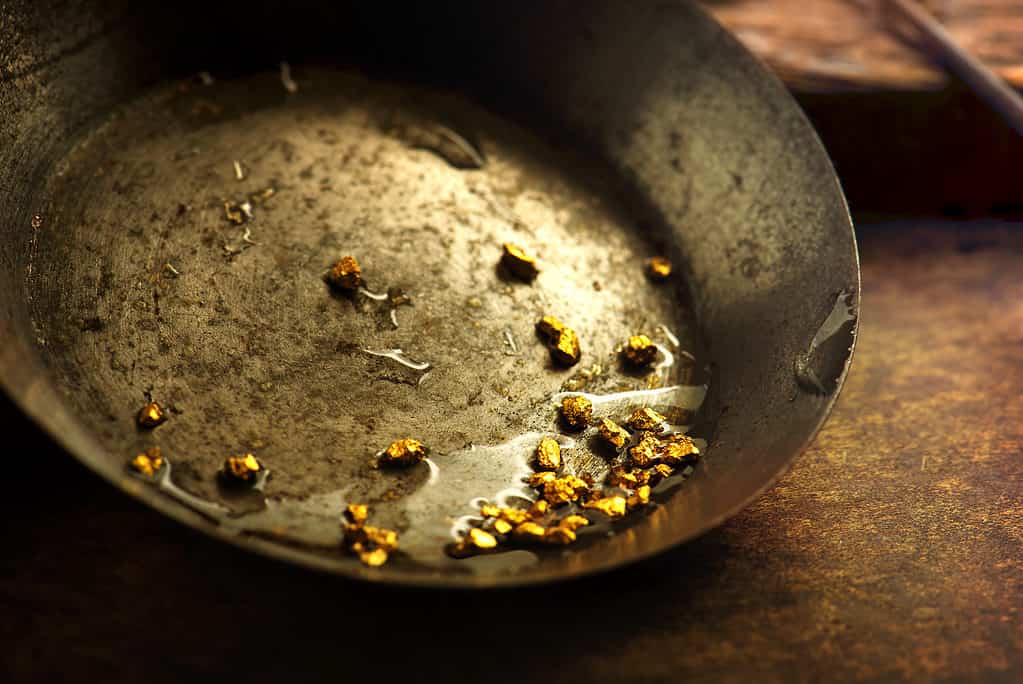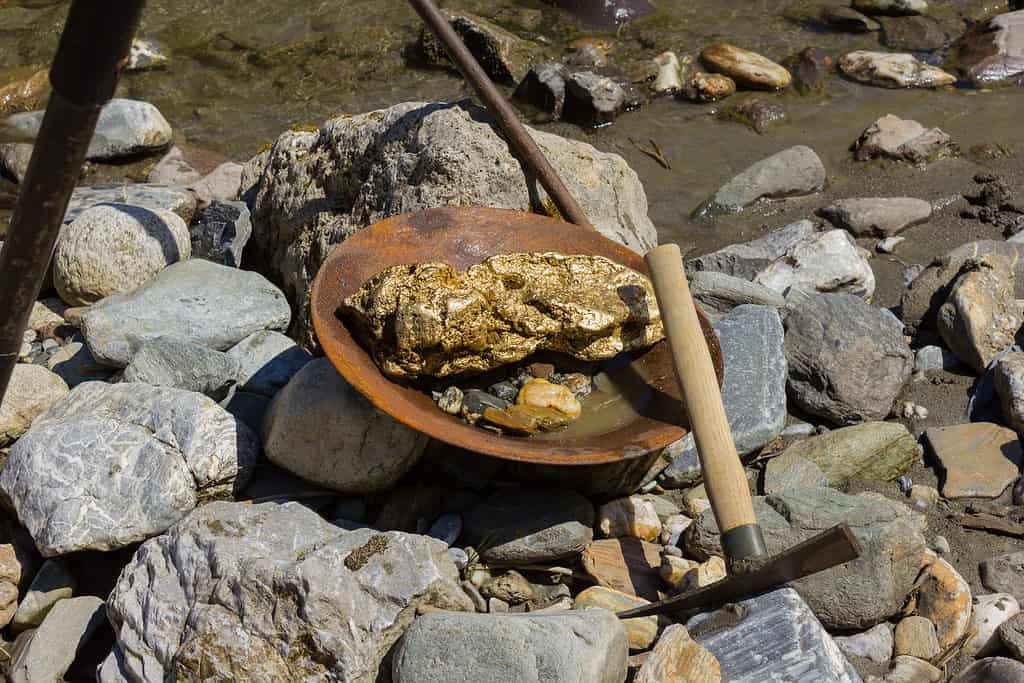The roots of the Carolina Gold Rush can be found in a young boy’s decision to skip Sunday school. Conrad Reed was twelve years old in 1799 when he decided to skip stones in Little Meadow Creek, North Carolina, rather than sit in class.

It was then that he saw an unusual-looking yellow stone rippling in the water. He managed to lug the 17-pound rock to his home where it was marveled at as a doorstop.
This rough golden stone sat in front of the door until one day when a jeweler asked to bring it to his shop so it could be cleaned. He returned it and offered what equates to roughly $84 in exchange for it.
A 17-pound golden nugget then would have been worth roughly $3,600, which equates to $87,222 today. That young boy would come to realize the opportunity he had, and founded a profitable gold mine that would serve as the impetus for the nation’s original gold mining boom.
Where Is Little Meadow Creek on a Map?
Little Meadow Creek is a 6.32 mile long tributary of the Rocky River, northeast of Charlotte, North Carolina. The Reed Gold Mine has its address in the town of Midland and is both a National Historic Landmark and on the National Register of Historic Places.
The Reed Mine would go on to find the largest unverified gold nugget in North Carolina. Anecdotal evidence suggests that they discovered a 28-pound nugget.
The largest confirmed nugget in North Carolinian history, though, was 23 pounds and was also found near the Reed Mine.

The largest confirmed gold nugget discovered in North Carolina was 23 pounds at the Reed Mine.
©Zack Frank/Shutterstock.com
The Largest Confirmed Nugget in North Carolina
Nearly 100 years later, three men walked along a road near the creek where that first nugget was found. Jacob Shinn, Dr. J.R. Jerome, and A.M. Cox led a dig into the road which had been relatively untouched. Mining explorations had taken place all around the road, but the road itself was so crucial to the operation that it had never been excavated.
It was April 9th, 1896, and Jacob Shinn didn’t have to dig far to find what he was looking for. Just over 3 feet into the earth, he found the “Shinn Nugget” which weighed 23 pounds.
The men were so excited when they walked back through town to have it examined that others commented that they were either drunk or deliriously happy about finding gold. At that time, the nugget was valued at just under $5,000. Today, it would be worth roughly $117,000, adjusted for inflation.
Conditions of the First Gold Rushes
The fact that Conrad Reed happened to discover gold was pretty spectacular, especially considering the fact that others had spent considerable time trying to find precious metals in the same area.
The Appalachian Mountains were the target of Spaniards and other colonists for hundreds of years. “Cities of Gold” were even on Coronado’s mind as he traveled through the modern-day United States in the 1540s.
North Carolina hosted the earliest American rush, but the “California Gold Rush” was more significant to the history of the country. Gold was discovered in the Sacramento Valley and people flooded from far and wide, eventually striking gold in a number of places along the Sierra Nevada Mountains.
The sudden influx of Europeans caused significant destruction and death for the indigenous people living in the area. People who were living in California’s beautiful environment were forced to relocate after being respectful stewards for generations. This fact is often overshadowed by the lore of the California Gold Rush.

The California Gold Rush was even more significant to the history of the country than what was discovered in North Carolina.
©optimarc/Shutterstock.com
The Journey to California and Miners’ Lives
The miners flooding California typically moved there because there wasn’t work elsewhere. If there was work, it was brutal for the working class. Industrialization was booming and few, if any, laws were in place to protect the health and well-being of workers.
Long hours, terrible conditions, and low pay were the hallmark working conditions of the period. So, the gold rush offered a glimmer of hope.
If one were lucky, maybe they could get rich or else support their family more reliably. If miners were traveling from the east, as many were, they faced countless obstacles and hardships on their way to the gold rush. Many traveled in wagons, as it would be a few more years until the transcontinental railroad reached California in 1869.
That meant they had to cross the Rocky Mountains, rivers, plains, and more. When they arrived, they faced working conditions more or less similar to the ones they faced before. Still, a great many people made more money than they would have if they stayed in factories.

The discovery of gold drove people to overcome great challenges and distances in search of a better life.
©Flugklick/Shutterstock.com
Why is Gold So Valuable?
Interestingly, we still don’t understand a great deal about why gold emerges where it does. The formation of gold predates the formation of the earth. Some suggest that it arrived on asteroids before heating up and sinking deep into the planet where this ever-valuable substance waits before it migrates upward in various ways.
Humans have been valuing gold for thousands of years. Caves occupied by people 40,000 years ago have been discovered containing gold.
It’s sought after for its aesthetic appeal, malleability, and rarity. It may seem like gold is everywhere, but there actually isn’t all that much floating around. Some estimates say that all of the mined gold above the Earth’s surface would fit into a 68-foot by 68-foot cube.
That’s why a 23-pound chunk is worth more than $100,000. There’s a great deal left inside the earth, though. Maybe you’ll strike riches the next time you’re skipping stones over a local creek.
The photo featured at the top of this post is © iStock.com/Oat_Phawat
Sources
- GSI Exchange, Available here: https://gsiexchange.com/learn/where-is-gold-found-on-earth/
- National Mining Hall of Fame and Museum, Available here: https://www.mininghalloffame.org/hall-of-fame/conrad-reed
- World History Encyclopedia, Available here: https://www.worldhistory.org/article/1754/cibola---the-seven-cities-of-gold--coronado/
- Mining Technology, Available here: https://www.mining-technology.com/features/californian-gold-mining/
- Gold Eagle, Available here: https://www.gold-eagle.com/article/history-gold
Thank you for reading! Have some feedback for us? Contact the AZ Animals editorial team.







